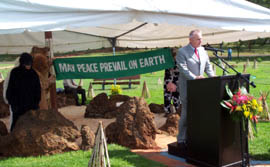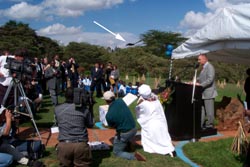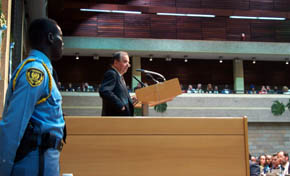 |
|
Prior
to the opening of CITES-11, delegates, guests and staff gathered
in the Memorial Garden for a "Moment of Reflection". Attendees
heard traditional Kenyan songs, speeches from representatives of
youth groups and civil society, and prayers from different religious
groups.
|
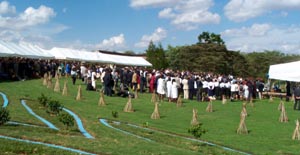 |
|
|
CITES-11
participants gathered in the garden under the motto "may peace
prevail on Earth". Tore Brevik, Director of UNEP Communications
and Public Information, was the Master of Ceremonies. |
|
Shafqat
Kakakhel, Deputy Executive Director of UNEP, speaking on behalf
of Dr. Klaus Töpfer, highlighted the three themes of the gathering:
peace, dialogue and tolerance.
|
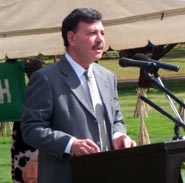 |
|
|
At
the conclusion of the event, butterflies were released to symbolize
the three themes. |
|
Official
Opening Ceremony
|
|
|
It
was standing-room-only as participants scrambled for seats.
|
 |
|
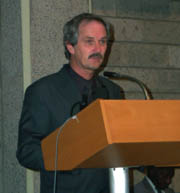
Willem Wijnstekers, CITES Secretary-General, noted the need for
applied synergy with other multilateral environmental agreements
(MEAs), particularly biodiversity-related MEAs, in order to strengthen
the Convention's capacity and success. He highlighted the importance
of the proposed Strategic Vision through 2005 as a means to ensure
that no animal or plant becomes subject to unsustainable exploitation
because of international trade. He called for attention to all proposals
for amendments, not just the high profile discussions on elephants,
whales, sharks and sea turtles.
|

Robert Hepworth (UK), Chair of the CITES Standing Committee, remarked
that approximately 6 billion human beings are dependent on wildlife
for food, fuel, medicine and their livelihoods, but refuted the
perceived conflict in meeting both human and wildlife needs. He
attributed CITES success to its practical concept of regulating
or prohibiting trade, its ability to evolve, and the hard work
of governments in implementing the agreement.
 RealAudio of Mr. Hepworth address
RealAudio of Mr. Hepworth address
|
|
|
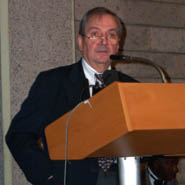 |
|
 Dr.
Klaus Töpfer, Executive Director of UNEP, called for comprehensive
consideration of all species proposed for amendments in Appendix
I, and urged the COP to focus on, inter alia: reduction of illegal
trade; enhanced public support and participation; improved financial
and administrative basis; conservation through biodiversity; development
processes; and protection of property rights. He recalled that causes
of biodiversity loss, such as poverty and debt, are common knowledge
and suggested that a new form of solidarity be created to protect
the global commons. Quoting Einstein, he concluded by stating that
"yesterday's problems cannot be solved with yesterday's thinking". Dr.
Klaus Töpfer, Executive Director of UNEP, called for comprehensive
consideration of all species proposed for amendments in Appendix
I, and urged the COP to focus on, inter alia: reduction of illegal
trade; enhanced public support and participation; improved financial
and administrative basis; conservation through biodiversity; development
processes; and protection of property rights. He recalled that causes
of biodiversity loss, such as poverty and debt, are common knowledge
and suggested that a new form of solidarity be created to protect
the global commons. Quoting Einstein, he concluded by stating that
"yesterday's problems cannot be solved with yesterday's thinking".
|
|
Tore
Brevik presided over the opening ceremony.
|
 |
|



